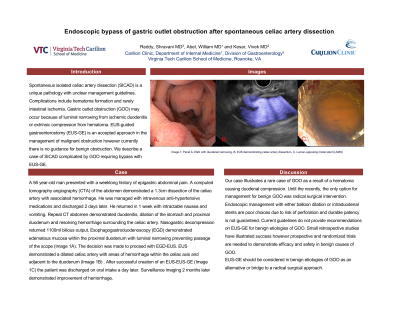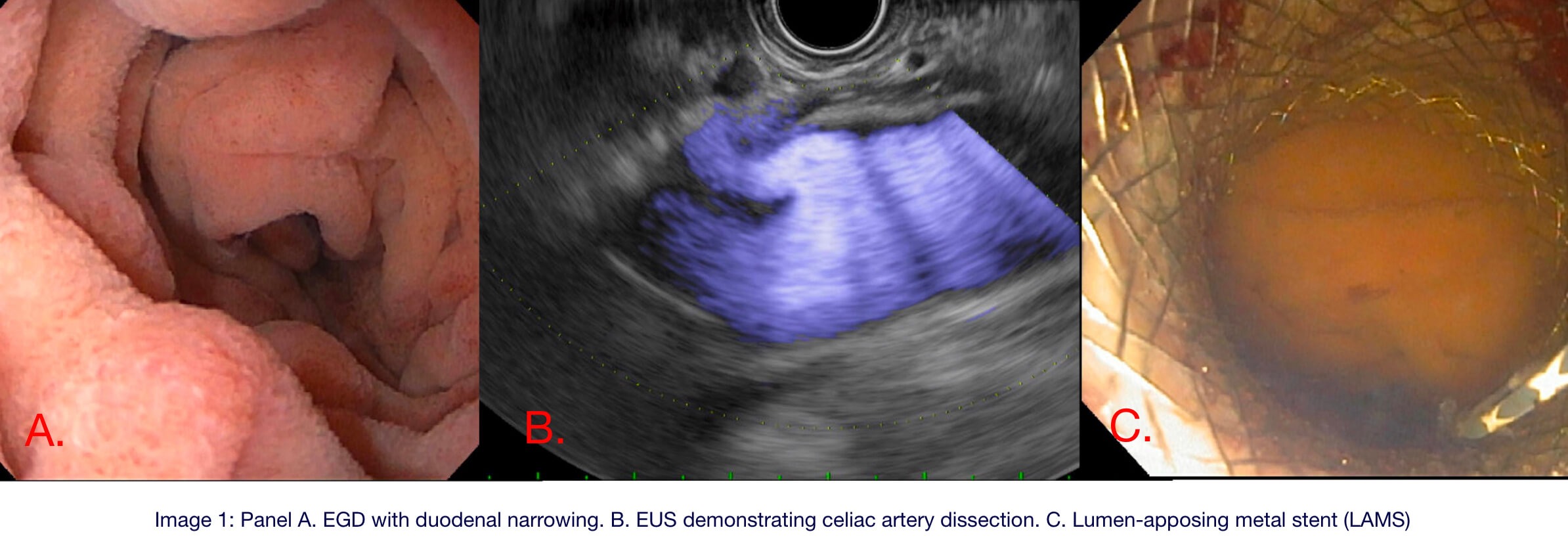Back


Poster Session C - Monday Afternoon
Category: Interventional Endoscopy
C0476 - Endoscopic Bypass of Gastric Outlet Obstruction After Spontaneous Celiac Artery Dissection
Monday, October 24, 2022
3:00 PM – 5:00 PM ET
Location: Crown Ballroom

Has Audio

William Abel, MD
Virginia Tech Carilion School of Medicine
Roanoke, VA
Presenting Author(s)
Shravani Reddy, MD1, William Abel, MD1, Vivek Kesar, MD2
1Virginia Tech Carilion School of Medicine, Roanoke, VA; 2Virginia Tech Carilion, Roanoke, VA
Introduction: Spontaneous isolated celiac artery dissection (SICAD) is a unique pathology with unclear management guidelines. Complications include hematoma formation and rarely intestinal ischemia. Gastric outlet obstruction (GOO) may occur because of luminal narrowing from ischemic duodenitis or extrinsic compression from hematoma. EUS-guided gastroenterostomy (EUS-GE) is an accepted approach in the management of malignant obstruction however currently there is no guidance for benign obstruction. We describe a case of SICAD complicated by GOO requiring bypass with EUS-GE.
Case Description/Methods: A 56 year-old man presented with a weeklong history of epigastric abdominal pain. A computed tomography angiography (CTA) of the abdomen demonstrated a 1.3cm dissection of the celiac artery with associated hemorrhage. He was managed with intravenous anti-hypertensive medications and discharged 2 days later. He returned in 1 week with intractable nausea and vomiting. Repeat CT abdomen demonstrated duodenitis, dilation of the stomach and proximal duodenum and resolving hemorrhage surrounding the celiac artery. Nasogastric decompression returned 1100ml bilious output. Esophagogastroduodenoscopy (EGD) demonstrated edematous mucosa within the proximal duodenum with luminal narrowing preventing passage of the scope. The decision was made to proceed with EGD-EUS. EUS demonstrated a dilated. Celiac artery with a areas of hemorrhage within the celiac axis and adjacent to the duodenum. After successful creation of an EUS-GE the patient was discharged on oral intake a day later. Surveillance imaging 2 months later demonstrated improvement of hemorrhage.
Discussion: Our case Illustrates a rare case of GOO as a result of a hematoma causing duodenal compression. Until the recently, the only option for management for benign GOO was radical surgical intervention. Endoscopic management with either ballon dilation or intraduodenal stents are poor choices due to risk of perforation and durable patency is not guaranteed. Current guidelines do not provide recommendations on EUS-GE for benign etiologies of GOO. Small retrospective studies have illustrated success however prospective and randomized trials are needed to demonstrate efficacy and safety in benign causes of GOO.

Disclosures:
Shravani Reddy, MD1, William Abel, MD1, Vivek Kesar, MD2. C0476 - Endoscopic Bypass of Gastric Outlet Obstruction After Spontaneous Celiac Artery Dissection, ACG 2022 Annual Scientific Meeting Abstracts. Charlotte, NC: American College of Gastroenterology.
1Virginia Tech Carilion School of Medicine, Roanoke, VA; 2Virginia Tech Carilion, Roanoke, VA
Introduction: Spontaneous isolated celiac artery dissection (SICAD) is a unique pathology with unclear management guidelines. Complications include hematoma formation and rarely intestinal ischemia. Gastric outlet obstruction (GOO) may occur because of luminal narrowing from ischemic duodenitis or extrinsic compression from hematoma. EUS-guided gastroenterostomy (EUS-GE) is an accepted approach in the management of malignant obstruction however currently there is no guidance for benign obstruction. We describe a case of SICAD complicated by GOO requiring bypass with EUS-GE.
Case Description/Methods: A 56 year-old man presented with a weeklong history of epigastric abdominal pain. A computed tomography angiography (CTA) of the abdomen demonstrated a 1.3cm dissection of the celiac artery with associated hemorrhage. He was managed with intravenous anti-hypertensive medications and discharged 2 days later. He returned in 1 week with intractable nausea and vomiting. Repeat CT abdomen demonstrated duodenitis, dilation of the stomach and proximal duodenum and resolving hemorrhage surrounding the celiac artery. Nasogastric decompression returned 1100ml bilious output. Esophagogastroduodenoscopy (EGD) demonstrated edematous mucosa within the proximal duodenum with luminal narrowing preventing passage of the scope. The decision was made to proceed with EGD-EUS. EUS demonstrated a dilated. Celiac artery with a areas of hemorrhage within the celiac axis and adjacent to the duodenum. After successful creation of an EUS-GE the patient was discharged on oral intake a day later. Surveillance imaging 2 months later demonstrated improvement of hemorrhage.
Discussion: Our case Illustrates a rare case of GOO as a result of a hematoma causing duodenal compression. Until the recently, the only option for management for benign GOO was radical surgical intervention. Endoscopic management with either ballon dilation or intraduodenal stents are poor choices due to risk of perforation and durable patency is not guaranteed. Current guidelines do not provide recommendations on EUS-GE for benign etiologies of GOO. Small retrospective studies have illustrated success however prospective and randomized trials are needed to demonstrate efficacy and safety in benign causes of GOO.

Figure: Image 1: Panel A. EGD with duodenal narrowing. B. EUS demonstrating celiac artery dissection. C. Lumen-apposing metal stent (LAMS)
Disclosures:
Shravani Reddy indicated no relevant financial relationships.
William Abel indicated no relevant financial relationships.
Vivek Kesar indicated no relevant financial relationships.
Shravani Reddy, MD1, William Abel, MD1, Vivek Kesar, MD2. C0476 - Endoscopic Bypass of Gastric Outlet Obstruction After Spontaneous Celiac Artery Dissection, ACG 2022 Annual Scientific Meeting Abstracts. Charlotte, NC: American College of Gastroenterology.
